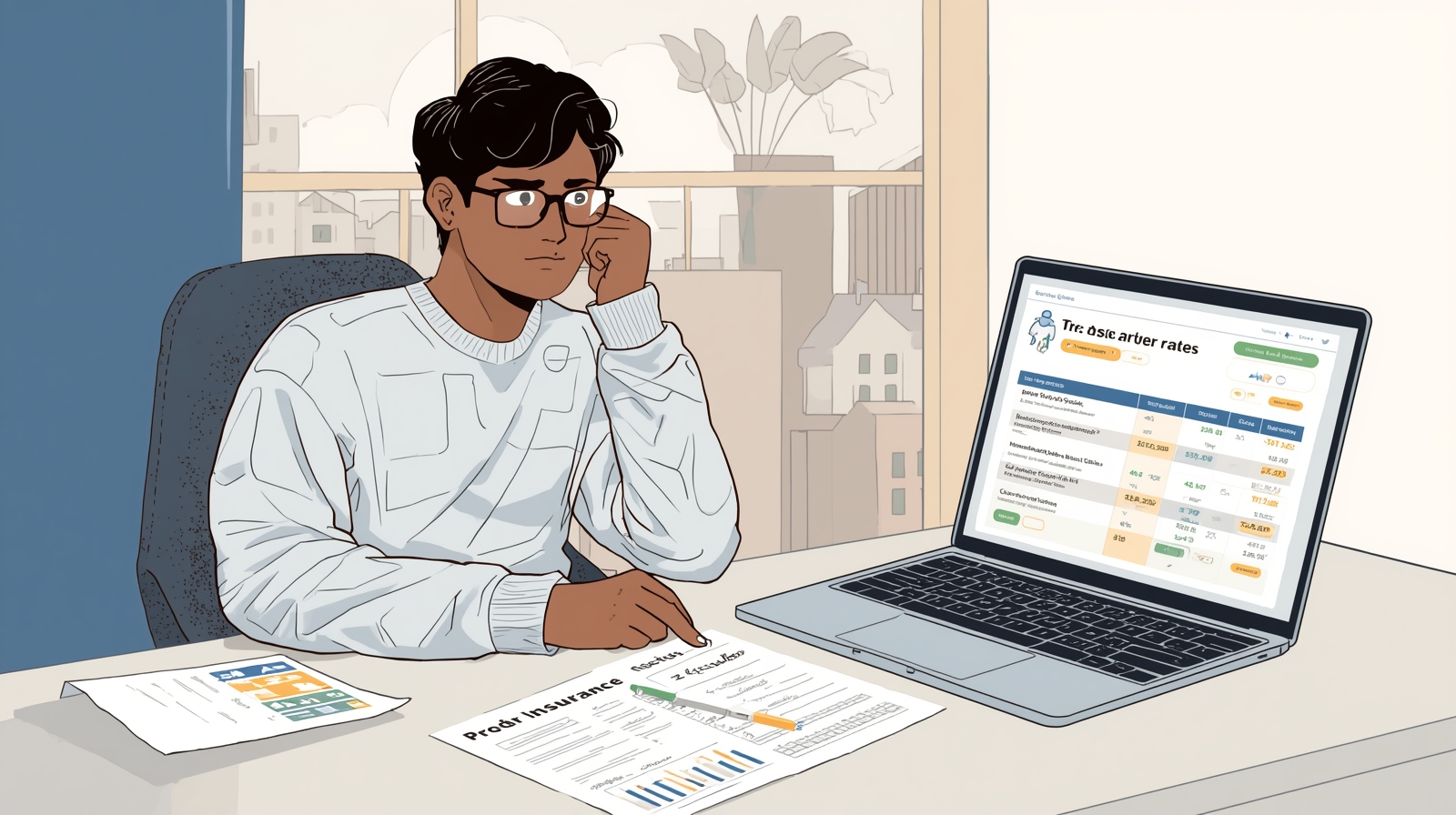Car insurance can feel like a mystery box. You pay a bill every month, but are you really getting the best deal? That’s where the idea of compare car insurance rates comes in. Comparing rates isn’t just about finding the cheapest plan. It’s about balancing cost, coverage, and peace of mind. In this guide, you’ll learn exactly how to compare rates effectively, what mistakes to avoid, and how to uncover savings that most drivers miss. We’ll also look at what competitors often leave out. By the end, you’ll feel confident enough to shop smartly and maybe even brag about your new lower premium.

Why Comparing Car Insurance Rates Matters
Many people stick with the same insurance company for years. However, loyalty doesn’t always pay off. Rates can change every six months, depending on the company’s risk models, claims history, and even your ZIP code. Comparing rates helps you stay informed. Moreover, it puts the power back in your hands, not the insurer’s.
Another big reason to compare is the “new customer discount.” Some companies lure new drivers with lower rates while quietly raising renewal prices. If you don’t compare, you may pay much more than you need to. Even a small difference, like $20 a month, adds up to hundreds of dollars a year.
Therefore, regular comparison is essential. Think of it like shopping for groceries. You wouldn’t buy milk without checking the price, right? The same applies to car insurance.
How Car Insurance Companies Set Their Rates
Before you compare, you should know how rates are built. Insurers don’t just pick numbers at random. They use dozens of factors, and many of them may surprise you.
Here are the most common ones:
- Driving history: Accidents, tickets, or DUIs will raise your rates.
- Age and gender: Young drivers pay more because they are statistically riskier.
- Location: Living in a busy city costs more than living in a small town.
- Credit score: In many states, your credit history affects your premium.
- Car type: A luxury SUV costs more to insure than a used sedan.
- Coverage level: Higher coverage equals higher premiums.
Understanding these factors gives you an advantage. When you know what insurers look for, you can adjust your habits and coverage to save money.
Steps to Compare Car Insurance Rates Effectively
Now that you know how rates work, let’s walk through the actual comparison process. Many drivers just get one or two quotes and stop. But that’s not enough.
Here’s a simple step-by-step method:
- Gather your details. Have your driver’s license, vehicle information, and past insurance documents ready.
- Decide coverage needs. Choose minimum legal coverage or full coverage, depending on your car and comfort.
- Request multiple quotes. Aim for at least five different insurers. Online tools make this faster.
- Check discounts. Look for bundling offers, safe driver rewards, or student discounts.
- Compare apples to apples. Make sure each quote includes the same coverage limits.
- Look beyond price. Cheap isn’t always best if the service is bad.
With this approach, you’re not just chasing the lowest price. Instead, you’re finding real value.

Mistakes to Avoid When Comparing Rates
Even smart shoppers make errors when comparing insurance. Avoiding these mistakes can save you both time and money.
First, don’t assume all companies calculate rates the same way. A ticket that raises your rate by $500 with one insurer may only raise it by $200 with another. Secondly, avoid focusing only on monthly payments. Some companies advertise a low monthly bill but sneak in high deductibles or hidden fees.
Another common mistake is ignoring customer reviews. Saving money isn’t worth it if the company is slow to handle claims. Finally, don’t forget to re-check every six months. Rates change, and the company that was cheapest today may not be cheapest next year.
When you dodge these mistakes, you’ll make better decisions and keep more money in your wallet.
Comparing Rates Online vs Through an Agent
There are two main ways to compare: online tools and insurance agents. Each has pros and cons.
Online comparison sites are fast and convenient. You can see dozens of quotes in minutes. They’re perfect if you like doing things yourself. However, they sometimes sell your information to third parties. That means more spam calls.
Agents, on the other hand, offer personal advice. Independent agents can pull quotes from multiple companies and explain the differences. The downside is that it may take longer. Also, some agents only work with specific insurers, which limits your options.
The best strategy? Use both. Start online to get a rough idea of prices, then consult an agent to dig deeper. That way, you get the speed of technology and the wisdom of human guidance.
How Often Should You Compare Car Insurance Rates?
This is one of the most common questions drivers ask. The simple answer: at least once a year. However, there are times when you should check sooner.
For example, if you move to a new state or city, your rates can change drastically. The same applies if you buy a new car, add a teen driver, or get married. Even improving your credit score can lower your premium.
Additionally, check your rates after any accident-free period. Some insurers offer discounts for safe driving over time. Don’t assume they’ll apply them automatically. By comparing often, you make sure no savings slip through the cracks.
Think of rate comparison as an annual checkup for your wallet. It keeps your insurance healthy and affordable.
Competitor Comparison: What They Miss
We looked at three popular blog posts on comparing car insurance rates. While they provide useful information, they fall short in several areas.
- Competitor A gave general advice but didn’t explain how insurers set rates. Without this, readers miss key context.
- Competitor B listed comparison tools but ignored the downsides of online-only shopping. Readers deserve balanced information.
- Competitor C focused on discounts but skipped mistakes to avoid. That leaves readers vulnerable to costly errors.
This guide fills those gaps. We explain rate-setting factors, share a clear step-by-step process, warn about mistakes, and balance online vs agent shopping. We also add practical tips, like when to re-check and how to maximize long-term savings. This level of detail isn’t found in competitor posts.

Tips to Save Even More Beyond Comparing Rates
Comparing rates is powerful, but it’s not the only way to save. Consider these additional strategies:
- Bundle policies: Combine auto and home insurance for a discount.
- Raise your deductible: A higher deductible lowers monthly payments, but only if you can afford it.
- Ask about usage-based insurance: Some companies track driving habits and reward safe drivers.
- Maintain good credit: A strong credit score often means lower rates.
- Take defensive driving courses: Certified courses can cut premiums by 5–15%.
These tactics stack with rate comparison. By combining them, you’ll maximize your savings while still keeping strong coverage.
Final Thoughts: Smart Shopping Pays Off
Car insurance is something most people pay for but rarely question. By learning how to compare car insurance rates the right way, you can break that cycle. You now understand how insurers set prices, how to compare effectively, and what mistakes to avoid. You also know when to shop and how to squeeze extra savings from discounts and bundles.
The truth is, comparing rates isn’t just about saving money. It’s about feeling confident that you’re not being overcharged. It’s about knowing your coverage matches your lifestyle and budget. Most importantly, it’s about taking control of your financial future.
So, the next time your renewal notice arrives, don’t just accept it. Compare. Ask questions. Explore options. Because every dollar you save on insurance is a dollar you can spend on the things you actually enjoy.




